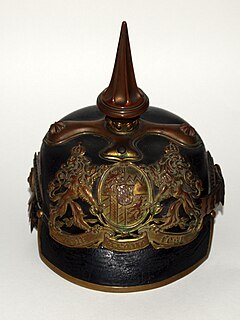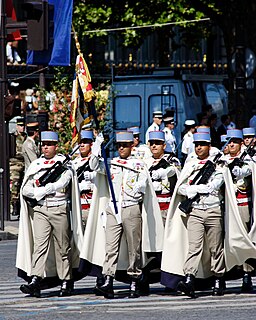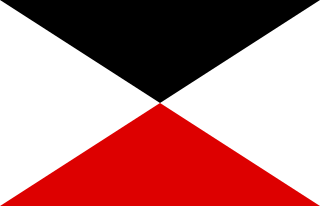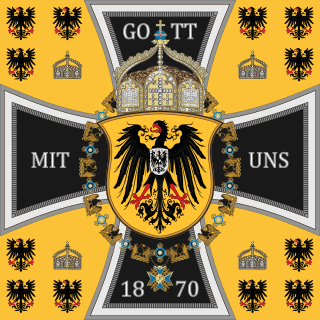
The Pickelhaube, also Pickelhelm, is a spiked helmet worn in the 19th and 20th centuries by Prussian and German military, firefighters and police. Although typically associated with the Prussian Army, which adopted it in 1842–43, the helmet was widely imitated by other armies during that period. It is still worn today as part of ceremonial wear in the militaries of certain countries, such as Sweden, Chile, and Colombia.

Cuirassiers were cavalry equipped with cuirass armour, sword, and firearms, first appearing in late 15th-century Europe. The first cuirassiers were produced as a result of armoured cavalry, such as the men-at-arms and demi-lancers, discarding their lances and adopting the use of pistols as their primary weapon. In the later 17th century, the cuirassier lost his limb armour and subsequently employed only the cuirass, and sometimes a helmet. By this time, the sword or sabre had become their primary weapon, pistols being relegated to a secondary function.

Spahis were light cavalry regiments of the French army recruited primarily from the indigenous populations of Algeria, Tunisia and Morocco. The modern French Army retains one regiment of Spahis as an armoured unit, with personnel now recruited in mainland France. Senegal also maintains a mounted unit with spahi origins as a presidential escort: the Red Guard.
The Cuirassier Regiment "Queen" (Pomeranian) No. 2 was a Prussian cavalry regiment. Formed in 1717 as Dragoner-Regiment Nr.5 Bayreuth Dragoner it was originally a dragoon regiment and was part of the Prussian order of battle until 1918. The Bayreuth Dragoons achieved fame for their role in winning the Battle of Hohenfriedberg in 1745. In 1819 it was transformed into a cuirassier regiment.

The von Blumenthal family are Lutheran and Roman Catholic German nobility, originally from Brandenburg-Prussia. Other (unrelated) families of this name exist in Switzerland and formerly in Russia, and many unrelated families called Blumenthal, without "von", are to be found worldwide.

A Garde du Corps is a military unit, formed of guards. A Garde du Corps was first established in France in 1445. From the 17th century onwards, the term was used in several German states and also, for example, in the Kingdom of Two Sicilies for several regiments of heavy cavalry, whose proprietary colonel was usually the sovereign.

The Brunswick Ducal Corps, commonly known as the Black Brunswickers in English and the Schwarze Schar or Schwarze Legion in German, were a military unit in the Napoleonic Wars. The corps was raised from volunteers by German-born Frederick William, Duke of Brunswick-Wolfenbüttel (1771–1815). The Duke was a harsh opponent of Napoleon Bonaparte's occupation of his native Germany. Formed in 1809 when war broke out between the First French Empire and the Austrian Empire, the corps initially comprised a mixed force, around 2,300 strong, of infantry, cavalry and later supporting artillery.

The IV Army Corps / IV AK was a corps level command of the Prussian and then the Imperial German Armies from the 19th Century to World War I.
The 1st Division was a unit of the Prussian/German Army. It was formed in Königsberg in March 1816 as a Troop Brigade (Truppen-Brigade). It became the 1st Division on September 5, 1818. From the corps' formation in 1820, the division was subordinated in peacetime to I Army Corps. The 1st Division was disbanded in 1919, during the demobilization of the German Army after World War I.

The Imperial German Army was the unified ground and air force of the German Empire. The term Deutsches Heer is also used for the modern German Army, the land component of the Bundeswehr. The German Army was formed after the unification of Germany under Prussian leadership in 1871 and dissolved in 1919, after the defeat of the German Empire in World War I.
The Royal Saxon Army was the military force of the Electorate (1682–1807) and later the Kingdom of Saxony (1807–1918). A regular Saxon army was first established in 1682 and it continued to exist until the abolition of the German monarchies in 1918. With the formation of the Confederation of the Rhine by Napoleon the Royal Saxon Army joined the French "Grande Armée" along with 37 other German states.
This is the German Army order of battle on the outbreak of World War I in August 1914.
The Bavarian Army was the army of the Electorate (1682–1806) and then Kingdom (1806–1919) of Bavaria. It existed from 1682 as the standing army of Bavaria until the merger of the military sovereignty (Wehrhoheit) of Bavaria into that of the German State in 1919. The Bavarian army was never comparable to the armies of the Great Powers of the 19th century, but it did provide the Wittelsbach dynasty with sufficient scope of action, in the context of effective alliance politics, to transform Bavaria from a territorially-disjointed small state to the second-largest state of the German Empire after Prussia.

Karl Ernst Manfred Freiherr von Richthofen was a German General der Kavallerie during World War I and recipient of the order Pour le Mérite, known informally as the Blue Max. Richthofen was a great uncle of his more famous namesake Manfred von Richthofen, known as the Red Baron, who was his godson and named after him.

Herrmann Gustav Karl Max von Fabeck was a Prussian military officer and a German General der Infantarie during World War I. He commanded the 13th Corps in the 5th Army and took part in the Race to the Sea on the Western Front and also commanded the new 11th Army on the Eastern Front. Subsequently, he commanded several German armies during the war until his evacuation from the front due to illness in 1916 and died on 16 December. A competent and highly decorated commander, von Fabeck is a recipient of the Pour le Mérite, Prussia's and Germany's highest military honor.
This article deals with the rank insignia of the Austro-Hungarian armed forces, as worn by the Austro-Hungarian Army after the reorganisation in 1867 until 1918.

The 10th (Magdeburg) Hussars Regiment (German: Magdeburgisches Husaren-Regiment Nr. 10) were a Prussian Light cavalry regiment of the IV Corps that was formed in late 1813 during the War of the Sixth Coalition against Napoleon after the Battle of Leipzig. The Hussars were a distinctively dressed light cavalry of East European origin. The 10th Hussars were stationed from 1814 to 1884 in Aschersleben and after 1884 in Stendal. They fought in 1866 at the Battle of Königgrätz and later in World War I.

The 2nd Guards Uhlan Regiment was a cavalry regiment of the Prussian Army formed in 1819 in Potsdam, Prussia, and served as a Guards regiment garrisoned in Berlin.
William Dietrich von Wakenitz, also Wackenitz or Wacknitz, 2 August 1728 on the family estate at Neu Boltenhagen–9 January 1805 in Kassel). He served in the Prussian army during the War of Austrian Succession and the Seven Years' War as a cavalry officer; subsequently, he served the Landgraviate of Hesse-Kassel as general and finance minister.
The 13 Cuirassier regiments of Old Prussia were formed in the mid-17th to mid-18th centuries, and formed the basis of Frederick the Great's vaunted cavalry.













